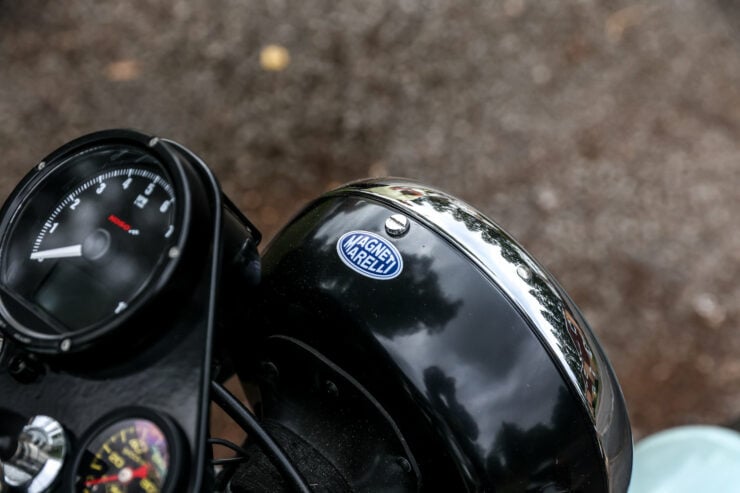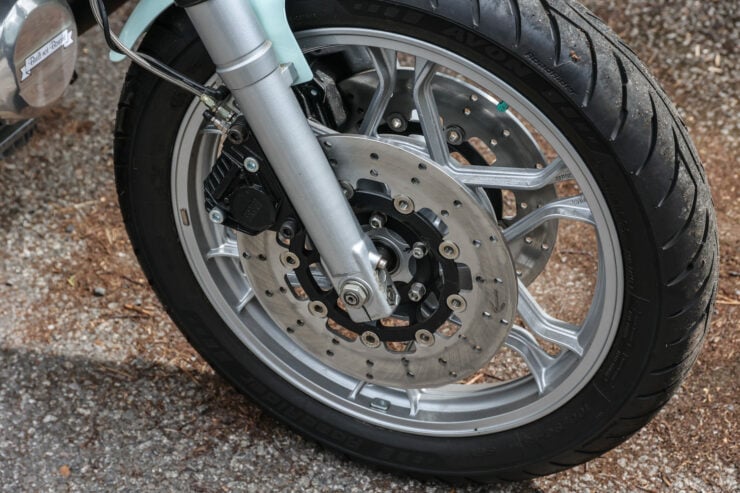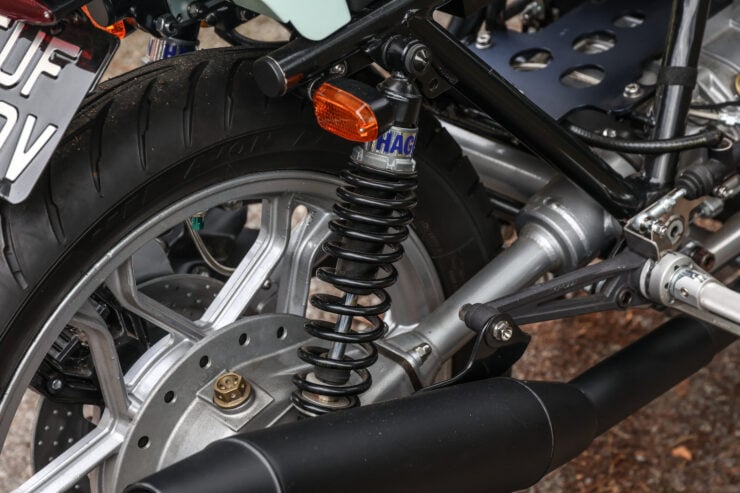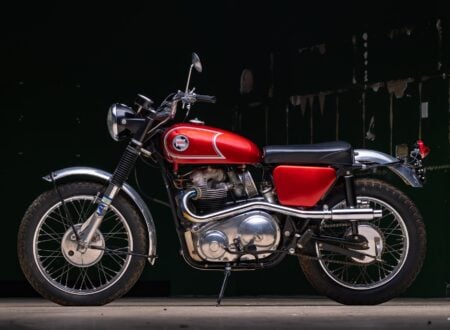This 1979 Moto Guzzi V1000 G5 benefits from a thorough restoration into a cafe racer-style custom. The rebuild included a full engine and carburetor rebuild as well as a slew of new parts inside and out.
The Moto Guzzi V1000 G5 has been described as the “Rottweiler of the motorcycle world” and it’s not hard to see why. It’s a dependable though heavy weight animal that tends to scare some while being beloved by its owners.
Fast Facts – The Moto Guzzi V1000 G5
- Moto Guzzi introduced the V1000 G5 in 1979, primarily as an evolution of the earlier 850 T3 and a sibling to the V1000 Convert. Positioned as a touring motorcycle, the G5 was designed to offer riders a combination of performance, comfort, and reliability suitable for long-distance journeys.
- The V1000 G5 was powered by a 949cc air-cooled, four-stroke, 90° V-twin engine, outputting approximately 61 bhp. This model had ample power for cruising, even with luggage or a passenger on the back, and the V-twin’s longitudinal orientation gave the bike its unmistakable Moto Guzzi character.
- One of the defining features of the V1000 G5 was its “integrated braking” system. This linked braking mechanism, when the rear brake pedal was pressed, also actuated one of the front disc brakes. This was an innovative approach that is said to have provided better stability and braking balance, especially during hard stops.
- The V1000 G5 you see here has been through a thorough rebuild into a modern cafe racer. It now features a new tank, seat, and rear cowl, as well as classic clip-on handle bars. The engine, brakes, and carburetors were all also rebuilt during the process.
The Moto Guzzi V1000 G5: A History Speedrun
The Moto Guzzi V1000 G5 was, by all accounts, a great motorcycle by the standards of the era it was released – the late 1970s. It was essentially a more palatable version of the earlier Moto Guzzi V1000 Convert which has been developed for police use, and given an unpopular three-speed semi-automatic transmission.


Both the V1000 G5 and the V1000 Convert were based on the earlier Moto Guzzi 850 T3, they were upgraded in a number of ways but perhaps most noticeably with the larger displacement 949cc longitudinally-oriented OHV V-twin.
In some respects, the V1000 G5 was developed to right the wrongs of the V1000 Convert. As the model name implies it was given a 5-speed manual gearbox (G5 = gearbox 5-speed), it also came with an unusual braking system that linked the foot brake to both the front right disc and the rear disc, with the handlebar lever operating the front left disc.
This system was intended to provide more balanced braking and many seemed to like it, but overall it didn’t catch on. That said, many other manufacturers have tried similar systems over the years with varying degrees of success.
The V1000 G5 was developed as a touring motorcycle and as such it came with a large windscreen, luggage racks, and panniers on either side.


Ultimately the V1000 G5 wouldn’t prove to be a particularly big seller for Moto Guzzi. This was a difficult time in the motorcycle world for European and American manufacturers as Japanese motorcycles flooded into their markets with lower sticker prices, and oftentimes better engineering.
Production ran from 1979 until 1985 with 3,857 units produced in total, though 3,000 of these are said to have been the military version. As a result, finding a good civilian-version of the V1000 G5 now can be a challenging task.
The Moto Guzzi V1000 G5 Cafe Racer Shown Here
The 1979 Moto Guzzi V1000 G5 comes from the first year of the model’s production run. At first glance it’s a little hard to tell what model it started out as, as the original V1000 G5 had a large fairing and saddle bags designed for touring.


The bike was bought by the current owner a few years ago as “a bit of a wreck” as he described it. The restoration took him a little over three years in total, and it’s resulted in one of the tidiest V1000-based customs we’ve seen in recent memory.
When the bike was first rolled into the workshop it was carefully stripped down, the frame was inspected, and then sent off to be professionally powder-coated in black. The alloy wheels were deemed to be in good condition and were powder-coated in silver at the same time to protect the underlying aluminum.
Rather than restoring the bike back to original factory condition it was decided to give it a new life as a cafe racer. To do this, the owner needed to source a new Manx-style fuel tank, a single seat with a rear cowl, and a pair of clip-on handlebars up front.
The engine was rebuilt with new Gilardoni 88mm pistons, piston rings, and a replacement barrel kit. The valves, guides, and springs were also added. The twin Dellorto PHF 36 carburetors and the gearbox were sent off to Germany and rebuilt by the specialists at HMB Guzzi.


Once it was all reassembled and fitted to the bike it was set-up by Dynojet Research on their rolling road, producing 55 bhp at the rear wheel. The brake calipers front and rear were rebuilt by Powerhouse, the front discs were custom made by EBC, and the master cylinder is a Brembo unit.
The last major thing left was the suspension, the front forks were rebuilt by Steve Jordan Motorcycles and a new pair of Hagon adjustable shock absorbers were fitted to the rear. A new wiring loom was custom made and fitted, along with a new Bosch starter motor and a Ricks Motorsport alternator.
The bike is now due to roll across the auction block with Historics Auctioneers with a price guide of £5,000 – £8,000 which works out to approximately $6,215 – $9,945 USD and you can visit the listing here if you’d like to read more or register to bid.





















Images courtesy of Historics Auctioneers








